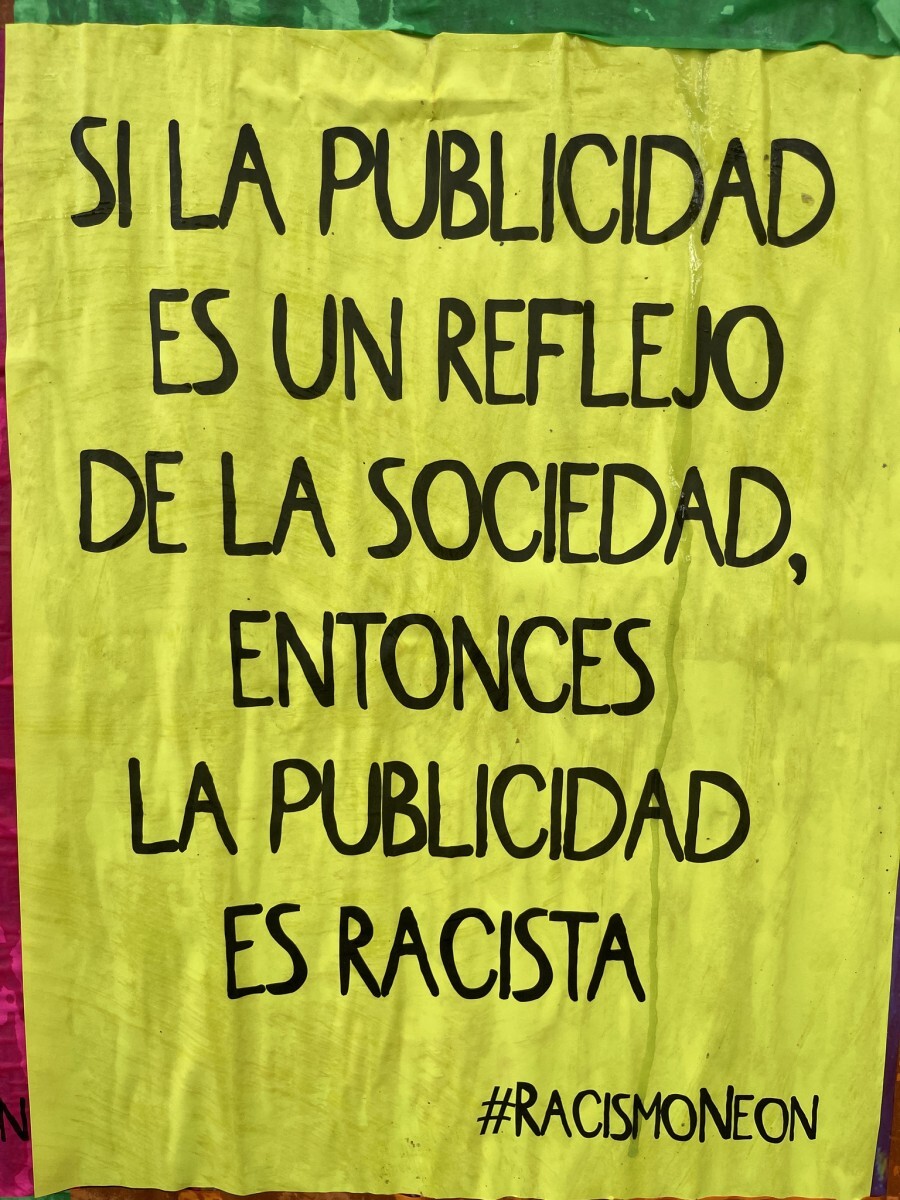| Titel | If advertising reflects society, then advertising is racist |
| Kampagne | #RacsimoNeon |
| Werbende | Carl W. Jones |
| Marke | #RacismoNeon |
| Datum der ersten Ausstrahlung/Veröffentlichung | 2022 / 7 |
| Geschäftsbereich | Gegen ethnische Diskriminierung |
| Slogan | #RacismoNeon |
| Story | Mid July 2022 in various neighbourhoods around Mexico City over 4,000 posters have appeared challenging the advertising community to produce less racist messaging. With headlines such as ‘Whites are 10% of the population but are in 70% of the ads’. Some Mexican brands choose to feature light skinned models to represent their Mexican products, ranging from beer to designer clothing. This so-called “aspirational advertising” has become common practice for most advertising agencies in Mexico, and Creative Director Carl Jones who is also a researcher at the Royal College of Art in London wants agencies to realize that they are re-enforcing racist and colonial thinking by selecting models with light skin to appear in the majority of advertising messages. Under the hashtag and social media pages #RacismoNeon’ Carl has created seven different posters printed on neon paper that are placed in locations where many ad agencies and their clients are located, such as Colonia Condesa, and La Roma. One poster placed by a local agency says “Advertising only shows indigenous culture in charity ads.’ Jones believes that it is time for advertising in Mexico to evolve, and help reflect the Mexican population as it really is. He notes that: “We need to remove colonial thinking from the creative process so that advertising will not reflect racism, misogyny etc, however there are some new advertising campaigns that attempt to be more inclusive such as Victoria beer that celebrates Mexican culture while featuring actors with darker skin.” Jones observes that “to eliminate racism from advertising I recommend that Mexican advertising agencies reflect the culture as it is, and not how brands pretend Mexican culture to be” The ‘Racismo Neon’ pages are on Twitter, Instagram y Facebook and feature the posters for people to comment on. This poster and social media campaign is designed to create conversation amongst workers in the advertising industry and have them discuss ways to remove colonial thinking such as white superiority from advertising messages. As a solution Jones suggests a change within actual advertising agencies, which are dominated by men in top positions. Even though more women are obtaining these roles, there needs to be more of a gender balance, and far more racial diversity is needed. Also in the hiring of actors, where the typical casting call asks for “International Latin American look’ which refers to models that have light skin, dark hair, and dark eyes. Finally, Jones suggests that regulatory bodies that govern advertising should be more proactive, creating specific rules that guide the ad industry before adverts become offensive. These solutions will help encourage inclusive messages and eliminate colonial thinking from advertising. |
| Philosophie | This poster and social media campaign is designed to create conversation amongst workers in the advertising industry and have them discuss ways to remove colonial thinking such as white superiority from advertising messages. The ‘Racismo Neon’ pages are on Twitter, Instagram y Facebook and feature the posters for people to comment on. |
| Problem | Some Mexican brands choose to feature light skinned models to represent their Mexican products, ranging from beer to designer clothing. This so-called “aspirational advertising” has become common practice for most advertising agencies in Mexico. A recent study in 2020 revealed that 70% of advertising feature white models while white represent only 10% of the total Mexican population. |
| Ergebnis | 4,000 posters placed on streets of Mexico in areas where ad agencies are located. On social media images of posters are uploaded. Over 1 million people reached on streets of Mexico and social media in first 2 weeks. A) coverage in Latin American advertising trade press: Latin Spots; Adlatina; Reforma newspaper , Roast Brief, and on many social media B) coverage in 'general' market newspaper Spanish language `El Pais' in Spain, Mexico and USA. Followed by AlJazeera (AJplusEspanol) on their social media channels reaching hundreds of thousands of readers. C) social media channel: Twitter, Instagram, Facebook the poster campaign was uploaded and comments are posted. along with many memes being created and conversation is generated on why advertising needs to remove colonial thinking such as racism are discussed. D) The most popular web destination for young people in Latin American Advertising Roast Brief holds a 1 hr panel on Linked -In/Youtube with top creatives and discuss the issue and search for solutions to remove colonial thinking from advertising. A commitment is made from the participants (Roast Brief and Circulo Creativo de Mexico) to continue the discussion. |
| Medientyp | Plakat |
| Markt | Mexiko |
| Mehr Informationen | https://twitter.com/RacismoNeon |
| Executive Creative Director | Carl W. Jones |
